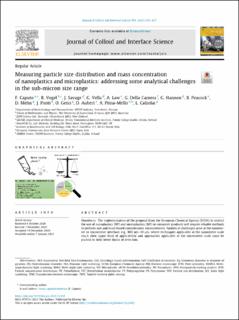| dc.contributor.author | Caputo, Fanny | |
| dc.contributor.author | Vogel, R. | |
| dc.contributor.author | Savage, J. | |
| dc.contributor.author | Vella, G. | |
| dc.contributor.author | Law, A. | |
| dc.contributor.author | Della Camera, Camera | |
| dc.contributor.author | Hannon, G. | |
| dc.contributor.author | Peacock, B. | |
| dc.contributor.author | Mehn, Dora | |
| dc.contributor.author | Ponti, J. | |
| dc.contributor.author | Geiss, Otmar | |
| dc.contributor.author | Aubert, D. | |
| dc.contributor.author | Prina-Mello, Adriele | |
| dc.contributor.author | Calzolai, Luigi | |
| dc.date.accessioned | 2021-11-15T07:58:19Z | |
| dc.date.available | 2021-11-15T07:58:19Z | |
| dc.date.created | 2021-04-21T12:52:39Z | |
| dc.date.issued | 2021 | |
| dc.identifier.citation | Journal of Colloid and Interface Science. 2021, 588 401-417. | en_US |
| dc.identifier.issn | 0021-9797 | |
| dc.identifier.uri | https://hdl.handle.net/11250/2829497 | |
| dc.description.abstract | HYPOTHESIS:The implementation of the proposal from the European Chemical Agency (ECHA) to restrict the use of nanoplastics (NP) and microplastics (MP) in consumer products will require reliable methods to perform size and mass-based concentration measurements. Analytical challenges arise at the nanometre to micrometre interface, e.g., 800 nm–10 µm, where techniques applicable at the nanometre scale reach their upper limit of applicability and approaches applicable at the micrometre scale must be pushed to their lower limits of detection. EXPERIMENTS:Herein, we compared the performances of nine analytical techniques by measuring the particle size distribution and mass-based concentration of polystyrene mixtures containing both nano and microparticles, with the educational aim to underline applicability and limitations of each technique. FINDINGS:Light scattering-based measurements do not have the resolution to distinguish multiple populations in polydisperse samples. Nanoparticle tracking analysis (NTA), nano-flowcytometry (nFCM) and asymmetric flow field flow fractionation hyphenated with multiangle light scattering (AF4-MALS) cannot measure particles in the micrometre range. Static light scattering (SLS) is not able to accurately detect particles below 200 nm, and similarly to transmission electron microscopy (TEM) and flow cytometry (FCM), is not suitable for accurate mass-based concentration measurements. Alternatives for high-resolution sizing and concentration measurements in the size range between 60 nm and 5 µm are tunable resistive pulse sensing (TRPS) and centrifugal liquid sedimentation (CLS), that can bridge the gap between the nanometre and micrometre range. | en_US |
| dc.language.iso | eng | en_US |
| dc.publisher | Elsevier | en_US |
| dc.rights | Navngivelse 4.0 Internasjonal | * |
| dc.rights.uri | http://creativecommons.org/licenses/by/4.0/deed.no | * |
| dc.subject | Risk assessment | en_US |
| dc.subject | ECHA microplastic restriction | en_US |
| dc.subject | Regulation | en_US |
| dc.subject | Particle concentration | en_US |
| dc.subject | Particle size distribution | en_US |
| dc.subject | Microplastic | en_US |
| dc.subject | Nanoplastic | en_US |
| dc.title | Measuring particle size distribution and mass concentration of nanoplastics and microplastics: addressing some analytical challenges in the sub-micron size range | en_US |
| dc.type | Peer reviewed | en_US |
| dc.type | Journal article | en_US |
| dc.description.version | publishedVersion | en_US |
| dc.rights.holder | Copyright: 2021 The authors | en_US |
| dc.source.pagenumber | 401-417 | en_US |
| dc.source.volume | 588 | en_US |
| dc.source.journal | Journal of Colloid and Interface Science | en_US |
| dc.identifier.doi | 10.1016/j.jcis.2020.12.039 | |
| dc.identifier.cristin | 1905580 | |
| cristin.ispublished | true | |
| cristin.fulltext | original | |
| cristin.qualitycode | 1 | |

